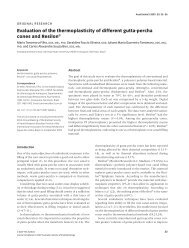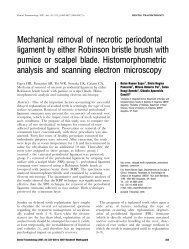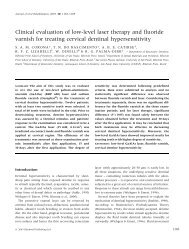Antimicrobial and mechanical properties of acrylic resins with ...
Antimicrobial and mechanical properties of acrylic resins with ...
Antimicrobial and mechanical properties of acrylic resins with ...
You also want an ePaper? Increase the reach of your titles
YUMPU automatically turns print PDFs into web optimized ePapers that Google loves.
6 L.A. Casemiro et al.Regarding the impact strength <strong>of</strong> the controlgroups, QC20 <strong>and</strong> Lucitone 550 had similar results.The higher impact strength observed for Lucitone550 was already expected as this is considered to bea high-impact material. QC20 <strong>and</strong> Lucitone 550differed significantly from Onda-Cryl, which presentedthe lowest impact strength (p < 0.05). Theaddition <strong>of</strong> percentages <strong>of</strong> 5–10% <strong>of</strong> IrgaguardB5000 zeolite to QC20 <strong>and</strong> Onda-Cryl significantlyreduced their impact strength, while the addition <strong>of</strong>2.5% <strong>of</strong> silver–zinc zeolite to Lucitone 550 decreasedits impact strength in comparison to thecontrol group.The results <strong>of</strong> the <strong>mechanical</strong> tests suggest thatzeolite addition may decrease the flexural <strong>and</strong> impactstrengths <strong>of</strong> <strong>acrylic</strong> <strong>resins</strong>, which is consistent<strong>with</strong> the findings <strong>of</strong> previous investigations. It isimportant to realise that the conversion degree <strong>of</strong>these materials relating to the amount <strong>of</strong> residualmonomer, may influence the values obtained 50,54 .Nevertheless, the addition <strong>of</strong> small percentages <strong>of</strong>zeolite to polymethylmethacrylate may be effectiveagainst microorganisms <strong>and</strong> therefore its impact on<strong>mechanical</strong> <strong>properties</strong> may be less significant thanthe potential benefits, especially for patients whodo not follow an adequate denture cleaning protocol9 . The major advantages <strong>of</strong> this addition couldbe for the elderly people <strong>with</strong> restricted manualdexterity or cognitive disturbances. A further adverseresult deriving from incorporation <strong>of</strong> zeolitesto <strong>acrylic</strong> <strong>resins</strong> was to increase the opacity <strong>of</strong>polymethylmethacrylate; the higher the percentage<strong>of</strong> zeolite added to the resin, the greater the opacity.Further studies are required to investigate thepossibility <strong>of</strong> avoiding this decrease in translucency<strong>of</strong> the <strong>acrylic</strong> resin base containing zeolites so as notto comprise the aesthetics <strong>of</strong> the prosthesis.ConclusionWithin the limitation <strong>of</strong> this preliminary study, itmay be concluded that the addition <strong>of</strong> low percentages<strong>of</strong> silver–zinc antimicrobial zeolites topolymethylmethacrylate can be a valuable alternativefor reducing microbial contamination <strong>of</strong><strong>acrylic</strong> resin denture bases, <strong>acrylic</strong> baseplates <strong>of</strong>removable orthodontic appliances, my<strong>of</strong>unctionalplates or other such devices.References1. Radford DR, Challacombe SJ, Walter JD. Dentureplaque <strong>and</strong> adherence <strong>of</strong> C<strong>and</strong>ida albicans todenture-base materials in vivo <strong>and</strong> in vitro. Crit RevOral Biol Med 1999; 10: 99–116.2. Keng SB, Lim M. Denture plaque distribution <strong>and</strong>the effectiveness <strong>of</strong> a perborate-containing denturecleanser. Quintessence Int 1996; 27: 341–345.3. Sesma N, Lagana DC, Morimoto S, Gil C. Effect <strong>of</strong>denture surface glazing on denture plaque formation.Braz Dent J 2005; 16: 129–134.4. Schneid TR. An in vitro analysis <strong>of</strong> a sustained releasesystem for the treatment <strong>of</strong> denture stomatitis.Spec Care Dentist 1992; 12: 245–250.5. Budtz-Jorgensen E. Oral C<strong>and</strong>idiasis in long termhospital care denture wearers <strong>with</strong> denture stomatitis.Oral Dis 1996; 2: 286–290.6. Kulak Y, Kazazoglu E. In vivo <strong>and</strong> in vitro study <strong>of</strong>fungal presence <strong>and</strong> growth on three tissueconditioning materials on implant supported completedenture wearers. J Oral Rehabil 1998; 25: 135–138.7. Muzyka BC. Oral fungal infection. Dent Clin NorthAm 2005; 49: 49–65.8. Chow CKW, Matear DW, Lawrence HP. Efficacy<strong>of</strong> antifungal agents in tissue conditioners in treatingc<strong>and</strong>idiasis. Gerontology 1999; 16: 110–119.9. Pietrokovski J, Azuelos J, Tau S, Mostavoy T.Oral findings in elderly nursing home residents inselected countries: oral hygiene conditions <strong>and</strong> plaqueaccumulation on denture surfaces. J Prosthet Dent1995; 73: 136–141.10. Abe Y, Ishii M, Takeuchi M, Ueshige S, Tanaka S,Akagawa Y. Effect <strong>of</strong> saliva on an antimicrobial tissueconditioner containing silver-zeolite. J OralRehabil 2004; 31: 568–573.11. Abe Y, Ueshige M, Takeushi M, Ishii M, AkagawaY. Cytotoxicity <strong>of</strong> antimicrobial tissue conditionerscontaining silver-zeolite. Int J Prosthodont 2003;16: 141–144.12. El-Charkawi H, el-Said EA, Safouh HM, el-RaghiN. Effect <strong>of</strong> addition antimicrobial agents to denturereliners. Egypt Dent J 1994; 40: 785–790.13. Matsuura T, Abe Y, Sato Y, Okamoto M, UeshigeM, Akagawa Y. Prolonged antimicrobial effect <strong>of</strong>tissue conditioners containing silver-zeolite. J Dent1997; 25: 373–377.14. Nikawa H, Yamamoto T, Hamada T, RahardjoMB, Murata H, Nakanoda S. Antifungal effect <strong>of</strong>zeolite-incorporated tissue conditioner against C<strong>and</strong>idaalbicans growth <strong>and</strong>/or acid production. J OralRehabil 1997; 24: 350–357.15. Ueshige M, Abe Y, Sato Y, Tsuga K, Akagawa Y,Ishii M. Dynamic viscoelastic <strong>properties</strong> one antimicrobialtissue conditioners containing silver-zeolite.J Dent 1999; 27: 517–522.16. Pesci-Bardon C, Fosse T, Serre D, Madinier I.In vitro antiseptic <strong>properties</strong> <strong>of</strong> an ammonium compoundcombined <strong>with</strong> denture base <strong>acrylic</strong> resin.Gerontology 2006; 23: 111–116.17. Imazato S, Kinimoto Y, Tarumi H, Torri M,Russel RRB, McCabe JF. Incorporation <strong>of</strong> AntibacterialMonomer MDPB into Dentin Primer. J DentRes 1997; 76: 768–772.Ó 2008 The Gerodontology Association <strong>and</strong> Blackwell Munksgaard Ltd, Gerodontology 2008; doi:10.1111/j.1741-2358.2007.00198.x






